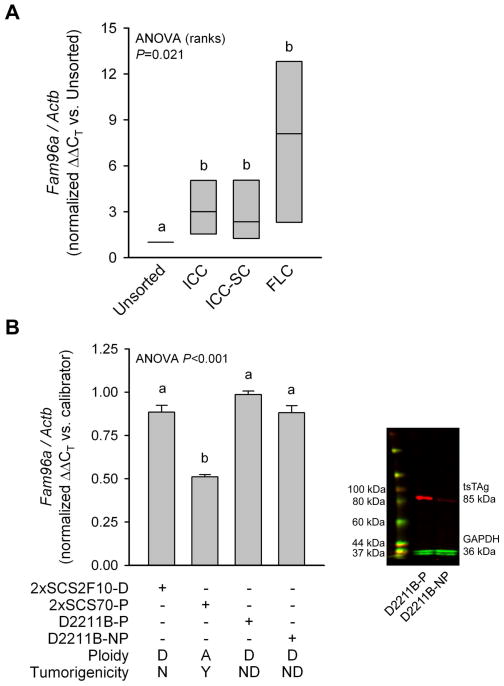Figure 5.
FAM96A is expressed in murine interstitial cells and precursors and is downregulated in tumorigenic ICC-SC. (A) FAM96A mRNA in FACS-purified ICCs, ICC-SCs and FLCs. Gastric muscles were obtained from 31 BALB/c mice (age: 10–20 days) and pooled into four cohorts for FACS. Groups not sharing the same superscript are significantly different by post-hoc multiple comparisons (Student-Newman-Keuls method). FAM96A expression was significantly higher in ICC, ICC-SC and FLC than in unfractionated cells. (B) FAM96A mRNA in tumorigenic and non-tumorigenic ICC-SC lines. 2xSCS2F10-D, 2xSCS70-P, D2211B-P and D2211B-NP cells are precursors or derivatives of the spontaneously transformed, aneuploid ICC-SC lines previously found to cause malignant, GIST marker-positive tumors in NCr-nu/nu mice.1 2xSCS2F10-D cells are diploid parent cells of the C57BL/6J-derived 2xSCS2F10 cells reported in ref.1 2xSCS2F10-D cells did not form tumors in NCr-nu/nu mice. The aneuploid 2xSCS70-P cells are direct descendants of the tumorigenic, Immortomouse-derived cells reported in ref.1 These cells were maintained under conditions permissive (-P) for the SV40 tsTAg. D2211B-P and D2211B-NP cells are diploid parent cells of the 2xSCS70 lines, and they were maintained under conditions permissive (-P) or nonpermissive (-NP) for the tsTAg. Right panel: verification of the loss of tsTAg expression in D2211B-NP cells after 5 days of culturing at 39.5°C in the absence of interferon-γ by Western blotting. A, aneuploid; D, diploid; N, no; Y, yes; ND, not determined. Groups not sharing the same superscript are significantly different by post-hoc multiple comparisons (Holm-Sidak method). Note reduced FAM96A expression in the tumorigenic 2xSCS70-P cell line. The presence or absence of tsTAg did not significantly affect FAM96A expression.

